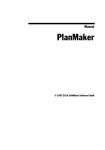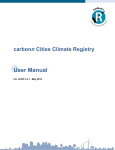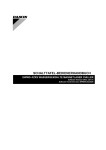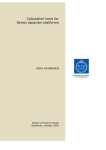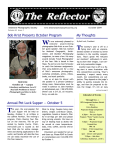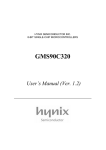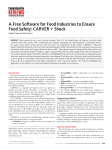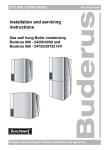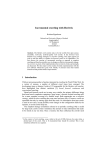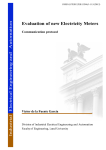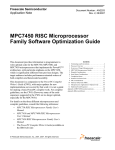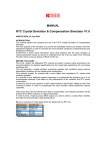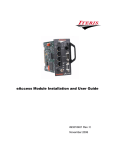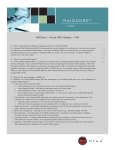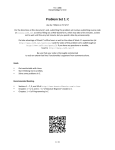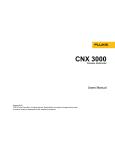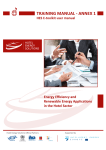Download Development of demonstration units for Siemens SPPA
Transcript
Development of demonstration units for Siemens SPPA-T3000 Control System Utveckling av demonstrationsenheter till Siemens SPPAT3000 Kontrollsystem Bachelor of Science Thesis in the Bachelor Degree Programme, Mechatronics CHRISTIAN GRUFFMAN KRISTINN SIGMUNDSSON Chalmers Supervisor: Morgan Osbeck Department of Automatic control, Automation and Mechatronics Division of Signals and Systems CH AL M E RS U NI V E R SI T Y OF T E CH NO LO GY Examiner: Kjell Brantervik Gothenburg, Sweden, 2007-12-15 Bachelor of Science Thesis: 2007 Development of demonstration units for Siemens SPPA-T3000 Control System CHRISTIAN GRUFFMAN KRISTINN SIGMUNDSSON Department of Automatic control, Automation and Mechatronics Division of Signals and Systems CHALMERS UNIVERSITY OF TECHNOLOGY Gothenburg, Sweden, 2007 Development of demonstration units for Siemens SPPA-T3000 Control System CHRIST IAN GRUFFM AN KRIST INN SIGM UNDSSON © CHRIST IAN GRUFFMAN, KRIST INN SIGMUNDSSON, 2007 Bachelor’s Thesis 2007 ISSN Department of Automatic control, Automation and Mechatronics Chalmers University of Technology SE-41296 Gothenburg Sweden Telephone +46 (0)31 772 1000 Development of demonstration units for Siemens SPPA-T3000 Control System CHRIST IAN GRUFFMAN KRIST INN SIGM UNDSSON Division of Signals and Systems Chalmers University of Technology PREFACE The work in this thesis was performed at Vattenfall Research & Development AB in Älvkarleby, Sweden. We would like to take the opportunity to thank all people at Vattenfall AB for an educating and giving time. Especially we want to thank our supervisor Mikael Nordlander at Vattenfall Research & Development AB for valuable guidance and suggestions to our work. We are grateful for his involvement of this thesis and the opportunity he has given us. We would also like to thank our supervisor Morgan Osbeck and examiner Kjell Brantervik at the division of signal and systems at Chalmers University of Technology for valuable criticism and support. ABSTRACT This thesis is a part of a larger study under the VISP project within Vattenfall AB. The work has been about realizing a comprehensive project that contained both hardware and software. There were no physical demonstration units to illustrate Siemens Power Plant Automation T3000 (SPPA – T3000) control systems functionality in an easy and understandable way. The only way to demonstrate it was in a complex virtual environment. Vattenfall AB needed to demonstrate the functionality and the different parts of the SPPA-T3000 control system in a more understandable way than was available. The purpose of this project was therefore to develop at least two out of three physical demonstration units, designed by us and use the built-in software for development of the Human Machine Interface (HMI) for the aforementioned control system. The first unit we built is called Vattenfall Illustrative Liquid Model and illustrates a simple control process, regulating the level of water in a tank. The second model called Vattenfall Environment Model and illustrates some of Vattenfall AB’s main power sources as Wind-, Hydro- and Coal Power producing electricity. Both physical units are connected to the SPPA – T3000 system and is controlled and illustrated with help of the built-in HMI system. The outcome of the project has been one fully operational demonstration units that illustrate the SPPA-T3000 functionality in an easy and understandable way, the second model is yet to be assembled by the workshop. The report is written in English. Keywords: Mechatronics, Vattenfall, Siemens Power Plant Automation T3000, SPPAT3000. SAMMANFATTNING Detta examensarbete ingår i en förstudie av VISP gruppen hos Vattenfall AB. Examensarbetet har innefattat att realisera ett övergripande projekt, innehållande konstruktion och förståelse av både mjuk- och hårdvara. Det fanns inga fysiska demonstrationsenheter eller virtuella program som kunde illustrera funktionaliteten hos Siemens Power Plant Automation T3000 (SPPA – T3000) mjukvara, på ett enkelt och logiskt sätt. Det enda sättet att demonstrera det på var via en komplex mjukvarubaserad modell. Vattenfall AB ville utveckla en demonstrationsutrustning för att på ett enklare och logiskt sätt kunna demonstrera systemets olika delar och funktionalitet. Syftet med detta examensarbete var att utveckla minst två av tre fysiska demonstrationsutrustningar, designade och utvecklade utav oss och med hjälp av SPPA – T3000’s egna utvecklingsverktyg konstruera ett Människa Maskin Interface (HMI) för dessa modeller. Den första modellen som byggdes kallas för Vattenfall Illustrativ Liquid Model och illustrerar en enkel kontrollprocess för reglering av höjdnivån av vatten i en behållare. Den andra modellen kallad Vattenfall Environment Model, illustrerar några av Vattenfall AB’s huvudsakliga energikällor i drift så som Vind-, Vatten- och kolkraft. Båda modellerna kopplas till SPPA – T3000 systemet och kontrolleras samt illustreras med hjälp av dess HMI system. Resultatet av examensarbetet har blivit en fullt funktionell demonstrationsutrustning som illustrerar SPPA – T3000 funktionalitet på ett enkelt och lättförståeligt sätt. Den andra modellen är komplett i beskrivning, programmering och visuellt monterad men saknar underliggande komponenter för styrning. Rapporten är skriven på Engelska. Nyckelord: Mekatronik, Vattenfall, Siemens Power Plant Automation T3000, SPPAT3000. TABLE OF CONTENTS NOMENCLATURE .................................................................................................. 1 1 2 3 4 INTRODUCTION AND OVERVIEW .......................................................... 3 1.1 PURPOSE.................................................................................................... 3 1.2 BACKGROUND ........................................................................................... 3 1.3 INCLUDED, EXCLUDED .............................................................................. 3 1.4 REPORT DISPOSITION ................................................................................ 3 METHOD ........................................................................................................... 4 2.1 ASSIGNMENT SPECIFICATION .................................................................... 4 2.2 PROJECT SPECIFICATION ........................................................................... 4 2.3 CREATING THE MODELS – FROM IDEA TO FINISHED PROTOTYPE ............ 5 SIEMENS POWER PLANT AUTOMATION T3000 ................................. 6 3.1 INTRODUCTION AND OVERVIEW ................................................................ 6 3.2 FIRST VIEWS ON THE PROGRAMMING ........................................................ 7 3.3 FUNCTION BLOCKS ................................................................................... 7 3.3.1 Decimal to binary converter (Dec2Bin) .................................................................8 3.3.2 Binary Pulse Generator ...........................................................................................8 3.3.3 Floor..........................................................................................................................8 3.3.4 Modulo ......................................................................................................................9 3.3.5 Pseudo Random Number Generator .......................................................................9 3.3.6 Sequential Function Chart FB ............................................................................ 10 POWER SUPPLY ........................................................................................... 10 4.1 SPECIFICATIONS ...................................................................................... 10 4.2 METHOD .................................................................................................. 11 4.2.1 5 How-to series connect two ATX computer PSUs to be able to supply 24VDC . 11 VATTENFALL ILLUSTRATED LIQUID MODEL ................................ 14 5.1 SPECIFICATION ........................................................................................ 14 5.2 PURPOSE.................................................................................................. 14 5.3 METHOD .................................................................................................. 14 5.4 THE CUBOID ............................................................................................ 15 5.4.1 5.5 5.5.1 5.6 5.6.1 5.7 5.7.1 5.8 6 7 9 WATER RESERVOIR AND VALVES .......................................................... 17 The Light Emitting Diodes .................................................................................... 18 THE CONTROL TANK ............................................................................... 19 Pressure Sensor MX2010DP ................................................................................ 19 THE PUMP AND PULSE-WIDTH-MODULATION – CIRCUIT........................ 20 How the Operation Amplifier was dimensioned ................................................. 22 ADDITIONAL ELECTRONICS .................................................................... 24 5.8.1 Couplings board .................................................................................................... 24 5.8.2 Relay board............................................................................................................ 24 VATTENFALL ENVIRONMENT MODEL .............................................. 25 6.1 SPECIFICATIONS ...................................................................................... 25 6.2 PURPOSE.................................................................................................. 26 6.3 METHOD .................................................................................................. 26 6.3.1 Landscape construction ........................................................................................ 26 6.3.2 Windmills ............................................................................................................... 28 6.3.3 Biomass/fossil fuel power plant............................................................................ 28 6.3.4 Programming ......................................................................................................... 28 VATTENFALL ROBOTIC ARM SIMULATION .................................... 28 7.1 8 LCD Display and buttons ..................................................................................... 15 SPECIFICATIONS ...................................................................................... 28 RESULT ........................................................................................................... 29 8.1 RESULTS .................................................................................................. 29 8.2 OPTIONAL ............................................................................................... 29 8.2.1 Continuing the work on VEM ............................................................................... 29 8.2.2 Connecting V-RAS to Siemens SPPA-T3000 ....................................................... 29 REFERENCES ................................................................................................ 31 APPENDIX NOMENCLATURE ABBREVIATIONS DCS = Distributed Control System ECS = Embedded Component Services™ FB = Function Block HMI = Human Machine Interface LCD = Liquid Crystal Display LED = Light-Emitting Diode PID = PID Controller (Proportional/Integral/Derivative) PMMA = Polymethyl Methacrylate PRNG = Pseudo Random Number Generator PSU = Power Supply Unit PWM = Pulse-Width Modulation SPPA = Siemens Power Plant Automation V-RAS = Vattenfall Robotic Arm Simulation VEM = Vattenfall Environment Model VILM = Vattenfall Illustrative Liquid Model EXPLANATIONS Trend = “A trend is the graphical representation of a variable's tendency, over time, to increase, decrease or remain unchanged”(1). When referring to trend in this report, trend is a “trend picture”, that is an HMI object displaying the trend of one or more signal values. Pictogram = A pictogram (also spelled pictogramme) or pictograph is a symbol representing a concept, object, activity, place or event by illustration(2). For instance in SPPA-T3000 a pictogram is a symbol for a motor or a valve. 1 2 1 1.1 INTRODUCTION AND OVERVIEW PURPOSE The purpose of this project is to demonstrate the functionality of Siemens Power Plant Automation T3000 control system (SPPA – T3000) in a logical way, with both physical demonstration units of our choice and the built-in software system. 1.2 BACKGROUND There are no physical demonstration units/programs to illustrate Siemens SPPA-T3000 functionality in an easy and understandable way. The only way to demonstrate it today is in a complex virtual environment. Vattenfall AB needs a better way of demonstrating the control system. This project will therefore develop at least two (out of three) demonstration units that in an easy and understandable way demonstrate Siemens SPPA-T3000 functionality. The built-in software will be used to control, program and monitor the models. 1.3 INCLUDED, EXCLUDED Extended technical information about the Siemens SPPA – T3000 Control System is excluded from this thesis. The economical aspect was taken into consideration when planning the projects, but we have not done an extended budget plan. Due to time issues the third model Vattenfall Robotic Arm Simulation, will not be constructed. Extended background information is excluded from the public thesis. 1.4 REPORT DISPOSITION • Introduction and Overview (page 3): Contains this reports introduction in form of purpose, background, included/excluded and report disposition. • Method (page 4): Describes how the models were created from the assignment specification delivery. • Siemens Power Plant Automation T3000 (page 6): Describes the aforementioned system and programming needed for the models. • Power Supply (page 10): Describes the development of the power supply unit used in this project. • Vattenfall Illustrated Liquid Model (page 14): Contains specification, purpose, method and results for the model. • Vattenfall Environment Model (page 25): Contains specification, purpose, method and results for the model. • Vattenfall Robotic Arm Simulation (page 25): Contains specification, purpose, method and results for the model. 3 • Result (page 29): A brief summary of the results as well as recommendations on future work. • References (Page 31): Information sources for this report are presented here. 2 METHOD This chapter describes how the models were created from the assignment specification to delivery. It is separated into several chapters, one for each major part of the development process. Detailed construction and design information for each model isn’t included here but in each of the models specific chapters. 2.1 ASSIGNMENT SPECIFICATION The project started with an assignment specification received from Vattenfall AB (see Appendix L), where the major requirements on the demonstration units were that: • They should represent and visualize an easy understandable process. • They should be illustrative by using for example lights and/or movable parts. • They should be easy to set up and start. • Robustness and stability is more important than complexity. • The applications should demonstrate some of the control systems feature, such as alarm handling, trending etc. • At least one of the applications should be interactive and able to be controlled by a user without any knowledge of the system. • They should be realized with a total budget of 25.000SEK for materials and 20.000SEK for manufacturing workshop working hours 2.2 PROJECT SPECIFICATION After the assignment specification had been thoroughly reviewed, and both parts agreed on what was vital for the project and what wasn’t, several ideas started to take shape. After revising the assignment specification and sorted out ideas that wouldn’t fit, three remained and was named: • Vattenfall Illustrative Liquid Model (VILM) • Vattenfall Environment Model (VEM) • Vattenfall Robotic Arm Simulation (VRAS) It was decided that the models would be developed in the order as presented above with VRAS as an optional unit, should there be enough time to realize it. Time schedule, milestone plan and project budget was setup (see Appendix M – O). These along with the 4 rough specifications of the models was written in a Project Specification and given to Vattenfall for verification. 2.3 CREATING THE MODELS – FROM IDEA TO FINISHED PROTOTYPE After the project specification a general idea for the different models had already been put down on paper. Before development of the models could start, detailed specifications of functions, design, materials and different key components needed to be decided upon. The course of action here was: • Decide upon the key components vital for the models construction, such as an elevator for knowing a models required minimum height, pump dimensions for minimum size of a reservoir, power supply for knowing what currents and voltages can be provided, etc. • Finalize the design of the model and create the drawings necessary for the workshop. • Choose building materials according to needs such as strength, water proof and appearance. • Start ordering, and while waiting for parts look through what needs to be done in the programming. Do we need to create our own blocks for certain functions? Do we right now see anything that is going to be tough to solve? Try to solve it as quickly as possible ourselves, or can Siemens help us? That’s just a few of several questions that need to be answered, before the programming should start. • As soon as the materials start arriving it’s time to begin building the model. If needed give the workshop materials and plans. • Look into the electronics needed to realize all of the models functions. • When the model is physically put together and the electronics are done it is pretty much trial and error from here on. 5 A problem is found Brainstorm for a solution Test a possible solution Did it solve the problem? Finalize the solution Figur 2.1- Schematic view of problem solving 3 3.1 SIEMENS POWER PLANT AUTOMATION T3000 INTRODUCTION AND OVERVIEW The Siemens Power Plant Automation – T3000 (SPPA – T3000) Control System consists, instead of like a traditional Distributed Control System (DCS), of a single server for handling all parts needed to control a power plant (diagnostics, alarms, engineering etc.). This is then controlled by one software platform called Embedded Component Service™ (ECS), connecting all the parts and feeding them information from a single source, so no need for synchronization and the operator can access all the information he needs on one platform. SPPA – T3000 is right now the latest Figure 3.1- Embedded Component Services™ technology from Siemens within power plant instrumentations and controls. SPPA-T3000 is Java based and everything can be controlled either via a web browser or a stand-alone Java application. With an integrated web server the system can be easily controlled from distance, and it is easy to integrate in already existing IT infrastructure. This of course puts a huge demand on high IT-security. The HMI has the ability to be customized, different styles and views for different users, gives the system flexibility. 6 As mentioned earlier, everything is integrated in ECS, so while you have a HMI like in traditional DCSs you can also access all function blocks (FB), diagnostics and even force ports to specific values. See Figure 3.2 below for System difference between traditional DCS and SPPA-T3000. Figure 3.2 - System difference between traditional DCS and SPPA-T3000 3.2 FIRST VIEWS ON THE PROGRAMMING The first thing you notice when programming with Siemens SPPA-T3000 is that it’s made to control advanced processes. For instance, FBs for controlling engines with feedbacks and operating times is already built-in, along with more advanced math for temperature compensating, flow calculations etc. This project however is not an advanced control process, but a rather simple one with some sequence programming. So the simple programming needed for the project got a little more complicated as several functions needed to control these processes was missing. 3.3 FUNCTION BLOCKS The main function blocks that were needed and programmed for this project was: • • • • • • Decimal to binary converter (8bit) Binary Pulse Generator Floor Modulo Pseudo Random Number Generator Pseudo Random Number Generator With Intervals The rest of this chapter is dedicated not to specific functions used to program these FBs but to the logic behind each FB. 7 3.3.1 Decimal to binary converter (Dec2Bin) This FB was made by subtracting each of the bits represented decimal value, checking if the output was larger than 0 and in that case output true on that bit and sending the value to the next subtraction block, if not output false and send the previous value to the next subtraction block. An example of the workflow when converting decimal 173 to binary is presented in Table 3.1 Figure 3.3 - 8bit Decimal to binary converter Bit Bit7 (128) Bit6 (64) Bit5 (32) Bit4 (16) Bit3 (8) Bit2 (4) Bit1 (2) Bit0 (1) Subtraction 173-128=45 45-64=-19 45-32=13 13-16=-3 13-8=5 5-4=1 1-2=-1 1-1=0 Larger or eq to 0? Yes No Yes No Yes Yes No Yes Next Value 45 45 13 13 5 1 1 0 Resulting bit 1 0 1 0 1 1 0 1 Table 3.1Workflow when converting decimal 173 to binary Result: 17310 = 101011012 3.3.2 Binary Pulse Generator The function creates a binary pulse with set length and set pause times. It takes three inputs, one for run (true/false) and two for on/off-time (float). The logic was created by various delay and fixed pulse FBs. Figure 3.4 - Binary Pulse Generator 3.3.3 Floor Takes a float number as input and has two outputs: one for integers and one for the decimals. The logic behind this is made out of the Dec2Bin converter above but converts the binary back to decimal and outputs the decimals, which are a rest product of the conversion, separately. 8 Figure 3.5 - Floor function that includes decimal output 3.3.4 Modulo The result of a modulo operation (%) is the remainder of a division. For instance 13 mod 7 or 13%7 is 6 (7 goes one time into 13 and 6 is the remainder). The function takes two inputs, IN1 and IN2 (13 and 7 in the example above), and outputs the remainder. This was done by making a regular division, removing the integers and multiplying the decimals by the denominator. Figure 3.6 Modulo For instance, with IN1 = 273 and IN2 = 103 the following is performed: 273 = 2,65048 … 103 Using the Floor FB described above only the decimals are used and multiplied with 103 (IN2) This gives: 0,65048 … ∗ 103 = 67 273 𝑚𝑚𝑚𝑚𝑚𝑚 103 = 67 3.3.5 Pseudo Random Number Generator This block was implemented utilizing Park and Millers “Minimal standard” Pseudo Random Number Generator (PRNG) (3).The math behind it is the following: a = 16807 m = 2147483647 (231-1) seed = 1 (initial seed) seed = (a * seed) mod m The seed variable is used as the random number and is then sent back to make a new random number. The value of a is chosen because it is thoroughly tested and is proven to be pseudo random and generates numbers with full periodicity with the chosen m (that is, beginning at the initial seed it will loop through every number between 0-2147483647 before returning to the original seed). As you can see the PRNG is dependent of the operation modulo, and to develop a modulo FB a floor function is needed. So those two FBs has been developed solely for the PRNG, although they might come in handy later on. Later a and m was changed by experiments with other known primes (large although smaller than the ones used in Park & Millers “Minimal Standard”) to accommodate the fact that Siemens SPPA-T3000 only allows 9 significant numbers. This has the effect that 2147483647-2147483646 = 0, because they are both converted to 2.1474834*108. 9 Figure 3.7 -Two PRNGs one with intervals and one without 3.3.6 Sequential Function Chart FB This was an easy block to make, all that was needed was to utilize SPPA-T3000 own start/stop sequence diagram and link it so that each time it passes the last block it sends a signal to the reset port, to restart the sequence. 4 Figure 3.1 - SFC POWER SUPPLY This chapter describes all about the power supply unit (PSU) used for the models. 4.1 SPECIFICATIONS Our PSU consists of two series connected computer PSUs for the ATX (Advanced Technology Extended) form factor for newer motherboards (1995 and newer) that can deliver 520W each. This gives the project a large range of supply voltages for its components, even those with large current demands. We decided only to use the original 3.3, 5 and 12VDC from PSU1 along with the original 3.3 and 12VDC from PSU2 but even so a lot of voltages are available by combining these (see Table 4.1 Different output voltages from two series connected PSU's (using only 3.3, 5 and 12VDC)). GND 3,3 5 12 15.31 242 GND - 3.3 5 12 15.3 24 3,3 - - 1.7 8.7 12 20.7 5 - - - 7 10,3 19 12 - - - - 3.3 12 15.31 - - - - - 8.7 242 - - - - - - Table 4.1 Different output voltages from two series connected PSU's (using only 3.3, 5 and 12VDC) 1) 3.3V from PSU2 2) 12V from PSU2 10 4.2 METHOD We started out by deciding that whatever PSU we chose, it should be able to supply all our models with the power they need. The requirements were that the PSU should be able to supply voltages of 5, 12, 15 and 24VDC with currents of up to 10A @ 24VDC. Taking the requirements into consideration when brainstorming for ideas to the power supply, we were ultimately left with two choices: • Putting together several PSUs for each of the voltages needed. • To use two computer PSUs and series connect them. Considering the economical factor and the amount of current each of these need to supply, we decided upon using the series connected computer PSUs. The use of two PSUs in a series connection is not because of the added power it can supply but because the highest output voltage from them are 12VDC and this project needs 24VDC for several components. Series connecting two PSUs solves this problem. 4.2.1 How-to series connect two ATX computer PSUs to be able to supply 24VDC The first thing that needs to be done when using a computer PSU for anything other than powering up a computer is to make sure it starts directly when powered. This is done by connecting the only green wire there is, from pin 16 (Power on/PS_ON) with the ground from the PSU (this according to an ATX12V 2.0 and above standard molex connector (3) and (4), for other PSU Figure 4.2 - ATX12V 2.0 Connector standards refer to (5) and (6)) Pin 1 2 3 4 5 6 7 8 9 10 11 12 Name 3.3V 3.3V COM 5V COM 5V COM PWR_OK 5VSB 12V 12V 3.3V Color Orange Orange Black Red Black Red Black Gray Purple Yellow Yellow Orange Pin 13 14 15 16 17 18 19 20 21 22 23 24 Name 3.3V -12V COM PS_ON COM COM COM -5V +5V +5V +5V COM Table 4.2 - Pin layout according to ATX12V 2.0 standard Color Orange Blue Black Green Black Black Black White Red Red Red Black It was decided that both PSUs should be power by one 230VAC, so the power was wired from one PSU to the other (see Figure 4.3). 11 GND N ~230V L 12V 3,3V 3,3V 5V 0V 12V 5V 3,3V 15,3V 12V 5V 12V 17V 24V N Figure 4.3 - How-to: connect two computer PSUs to get 24VDC Furthermore the second PSU needed its neutral heightened to 12VDC, so 12VDC was connected from the first PSU to the neutral on the second one see Figure 4.4 - Two series connected PSUs. Figure 4.4 - Two series connected PSUs The important thing to consider here is that the PSU that has its ground potential heightened must not have its ground connected to the net, as that will cause a short circuit. Different voltages using only the 3.3, 5 and 12VDC outputs of both PSU’s are shown above in Table 4.1 Different output voltages from two series connected PSU's (using only 3.3, 5 12 and 12VDC). It’s even possible to get more outputs like, for instance 29VDC, by using – 5VDC from PSU1 and +12VDC from PSU2. In this project we ended up only using 3.3, 5 and 12VDC from PSU1 along with 3.3 and 12VDC on PSU2. Something to take into consideration is that some computer PSUs might not deliver a stable voltage if the 5V doesn’t have a load (7). We didn’t experience any problems that could be linked to this statement, but we did install a 5W load on each PSU as a pre-cautionary measure. When constructing our first model, VILM, we had some problems with one PSU shutting down and found the cause of this to be a very bad dimensioned PID controller. Problem was solved with a better PID controller that wouldn’t cause as high and frequent current spikes as the old one and with a coil connected between the PWM controller circuit and the pump. This limited the spikes that otherwise couldn’t be removed without developing a really slow control process. 13 5 5.1 VATTENFALL ILLUSTRATED LIQUID MODEL SPECIFICATION VILM is a process control system, regulating the water level in a cylindrical tank. The system is designed as a cuboid shaped box with acrylic glass on its sides and an aluminum frame, standing on its short side. Inside the box there is a cylindrical tank, hereafter referred to as the Control Tank, elevator, water- reservoir, pump, sheet metal stabilizer, two electric valves and one manual valve. At the front of the cuboid a Liquid Crystal Diode (LCD) display will show the set point value in percent. At startup the control tank will rise from within the cuboid through the top and lights in the waterreservoir and control tank will light up. In the centre of the control tank there is an acrylic glass Figure 5.1 - VILM: Finished model plate with Vattenfall AB’s logo milled in it that will light up in green, red or blue depending on the system status. The level of water can either be controlled through the HMI or with two buttons mounted beside the LCD display on the model. In the HMI it’s possible to choose between a good and a badly regulated process. A safety valve will open if the water gets a few percent above the max level, to ensure that the control tank doesn’t overflow. The manual valve and the electric valve can be used to simulate system disturbances. 5.2 PURPOSE In this project the purpose of VILM is to be a hand-on demonstration of the Siemens system, involving the audience by letting them change set point values and simulating system disturbances, VILM will be an interesting demonstration unit. It will mostly show the usage of different HMI controls, alarm/event handling, simple sequence programming and easily constructed pictograms. 5.3 METHOD When the development process with VILM began, we started by dimensioning the model. The model needed to be large enough to easily be seen and understood via a videoconference, and yet, still be portable. Then the search for components began. Before 14 ordering and construction could begin an elevator that could lift the cylindrical tank as high as necessary without it being too high itself was crucial , otherwise the model would need to be re-dimensioned to accommodate for the height of the chosen elevator. As the orders for the frame and elevator was sent, most of the models components were decided upon and ordered when needed, such as pressure sensor, valves and hoses. In case of small or major changes in the model that would make one or more components unusable in the project, everything wasn’t ordered at the same time. It was decided that the water reservoir would cover the bottom of the model with room for the elevator in the middle. Another major dimensioning was made when trying to find the right pump, and pump controls, for the regulating the water level in the control tank. It had to be able to sustain and fill the tank with water within a reasonable time, otherwise the process would be too slow, we especially looked at how many liters per hour and pressure height the pump could handle. When deciding how to control the pump the big issue was to find a cost effective controller, so a pulse-width-modulator (PWM) was bought. 5.4 THE CUBOID The cuboids frame is made up by alumina profiles (Profile 6) bought from Aluflex AB and its sides are covered by acrylic glass bought from Akriform Plast AB with a thickness of 2mm. The alumina profile dimensions was 30x30mm with a variety in height, the cuboid itself is 1060x560x560mm. At the bottom of the cuboid there are a wooden plate 525x525x10mm to provide as a stabilizer when mounting the sheet metal stabilizer and the elevator, and also as a mounting sheet for the diodes belonging to the water reservoir explained more in 5.5.1 Light Emitting Diodes. 5.4.1 LCD Display and buttons To get some feedback from the process, in the model, a LCD display was bought from Fractronics. As documentations from LCD displays varies a lot it was important to get one that had a HD44780 compatible control circuit. As these are a homebrew de-facto standard and a lot of documentation is available on these (see for instance (8) and (9)). It was decided that it ought to be controlled solely by SPPA-T3000, and given that the update rate on the system is 100ms it was known that the presentation of the set value would be a lot slower than with a microcontroller. It should be mentioned here that SPPAT3000 is not intended to control a LCD display and similar components, but rather large systems where an update rate of 100ms is more than enough. A separate connection circuit needed to be build because the signals given from the Siemens PLC is 24V and the display circuit can only handle 5V. The solution was a circuit 15 with photocouples and resistors at all signal in ports, that translates the PLC 24V to 5V signals (see Appendix C – D). The circuit was also fitted with two potentiometers to be able to set the contrast- and light strength. We started by connecting all the wires from the display through the translation circuit to ten digital outputs, and then writing a program that properly initialized it. From here on the programming grew organically as more functions were added, and in the end a fully functional LCD display controlled solely by SPPA-T3000 showed the correct set value on the model. There is a lot of room for optimization of this programming by using sequences for displaying the values, and using other output modules (so-called FUM, Function Modules) the display time could be cut down drastically (approximately by 90%). One of the main problems when testing the display apart from connecting it right, was that it sometimes wrote alien characters. The cause of this was that the signal cables where to near the power cables in the electronic box. The solution was to first separate the signal from the power cables, and to minimize possibility of disturbances the programming was changed to only write the set value when it was changed (not continuously as it previously did). The buttons are two ordinary stainless pressure buttons ordered from Conrad, their purpose is solely to change the set value manually without the HMI. They are directly connected to the digital in port at the Siemens PLC and they are programmed to be able to change the value by holding them down a longer time period. For instance a quick push changes the value by 1 point up or down, but holding a button down for five seconds changes the value about 50 points. 16 5.5 WATER RESERVOIR AND VALVES We wanted the water reservoir to cover the whole bottom of the tank, excluding a space in the middle for the mounting of the elevator (see Figure 5.2 - Water reservoir with sheet metal and valves), the plate seen at the bottom around the middle of sheet metals is actually the bottom of acrylic glass and not sheet metal). This made mounting the valves into a bit of a problem because they are over one kilogram each. A way to mount the valves in the model needed to be Figure 5.2 - Water reservoir with sheet metal and valves found and our solution was to design a sheet metal stabilizer, hereafter referred to as the sheet metal. To be able to fasten the sheet metal properly it was formed to cover the bottom of model under the elevator. Furthermore it was bent and shaped to cover one side on top of the reservoir and then bent up to follow the front side of the cuboid, allow for mounting the manual valve to have its handle outside the box (see Figure 5.3 - Perspective view of VILM). The sheet metal also provided as a good stabilizer for the elevator bought from Linak Scandinavia AB. The first water reservoir to be built was too thin, so when filled with water the sides became concave. It was constructed from 3mm Polymethyl methacrylate Figure 5.3 - Perspective view of VILM (PMMA) boards that were glued together. We decided that it did not meet our requirements on a robust construction. To get a more robust construction it was decided to build another water reservoir also built upon PMMA but with a thickness of 8mm. This tank meets our requirement and looked robust enough. A drain valve was mounted at the right lower corner of the tank for the use of draining and refilling the water reservoir. 17 5.5.1 The Light Emitting Diodes As the finished models are to be displayed to various types of personnel’s from Vattenfall an early decision was made to make the models informative as well as fun and flashy. As a result of this decision Light Emitting Diodes (LEDs) are extensively used in VILM. There are three sets of diodes in the control tank (explained more in chapter 5.6 The Control Tank) and there is also 16 blue LEDs in the bottom water reservoir. The LEDs in the water reservoir blinks a few times at startup and are then constantly light until the model is shutdown. The diodes (Ø3mm EL 202) were bought Figure 5.4 - Diode from Elfa, what was of interest for us (except color) were the specifications of voltage and current. We chose diodes with 2,0V and 20mA. Using our lab PSU set at 2V to test them (and later 6V for a series of three) we managed to burn a few of them. When connected we didn’t take into consideration that each diode series needed its own separate resistance, even if connected at the right amount of voltage. If connected without resistors the internal resistance of serial connected diodes is too small and causes a current flow, which short circuit them. 18 5.6 THE CONTROL TANK The control tank was the first feature of VILM that was designed. It is cylindrical with an acrylic plate in the middle that has Vattenfall ABs logo milled in it. Under this plate, in the bottom of the tank, Light Emitting Diodes (LED) in green, red and blue are mounted and light up the logo depending on the systems health: • Green for correct level • Blue for low level • Red for high level In Figure 5.5 - Bottom view of the control tank you can see a hole in the top drilled for pressure leveling and the holes in the middle- bottom for the LEDs. There are also 4 holes for fastening it to the elevator Figure 5.5 - Bottom view of the control tank and one small hole for the pressure sensor (see Appendix K). A problem that arose was that the acrylic we bought (PMMA) wasn’t hard enough to mill in, so the company that we order the milling from used their own material which wasn’t as thick as our (our acrylic plate was 8mm thick, theirs was 5mm). Because of this the LEDs wouldn’t fit as they were supposed to and more silicon was needed to ensure that the tank would be water proof. 5.6.1 Pressure Sensor MX2010DP When selecting a pressure sensor the most important specification to look at is the pressure range. The pressure range that is ideal for an application is one that is specified for the exact range that the application will work within. As this is never the case, one that is as close as possible with a high degree of sensitivity is mostly chosen. A pressure sensor that suited our needs was MX2010DP found at Elfa. This model sends an mV signal which can be worrisome. Sensors that Figure 5.6 - Pressure Sensor MX2010DP transmit with a mA signal are less 19 electromagnetic- and distance sensitive, but the price and pressure range suited the projects needs. The MX2010DP has a pressure range of 0 – 10kPa (0-1m water) which would be enough (the control tank is 0.4m high). The sensitivity is approximated 2,5mV/kPa, which means that the sensor sends a signal between 0-25mV for 0-10kPa, or in our case, 0-10mV for 0-4kPa. At first we thought this would be a problem, considering the rather small voltages and the Siemens systems analog input has the smallest setting of ±80mV, but test results proved that this was no problem for the control system. After changing the supply from our lab PSU (where it was tested with 10.0V to our modified PSUs 10.3V) to our modified computer PSUs the control system didn’t receive a signal from the pressure sensor, debugging with a multimeter showed that there was a signal, seemingly correct, sent from it. After some experimentation the supply was changed from an intended 10.3V to 5V, this gave us a smaller signal in to the control system, but with some compensating in the programming for the changes, we got correct values again (with no noticeable effects on accuracy or sensitivity). 5.7 THE PUMP AND PULSE-WIDTH-MODULATION – CIRCUIT The pump by its specifications should be able to handle 4500 liters per hour and be running on 12V @ 4A. This should have been fairly enough when reviewing our calculations. Our minimum requirement was that the pump should be able to keep the tank filled with one valve completely opened. That is the volume flow rate in (1.25 l/s) should be at least as large as the volume flow rate out. So we calculated the volume flow rate out in optimal conditions, assuming that: • The flow exiting the tank is steady, incompressible, and irrotational. • The water drains slowly enough that the flow can be approximated as steady (or quasi-steady as the tank begins to drain). • Water runs freely through the hoses, and there for Z2 can be set at the outlet of the control tank. Figure 5.7 - VILM sketch 20 Start by using Bernoulli equation (10): P1 ν 12 P ν2 + + z1 = 2 + 2 + z 2 ρg 2 g ρg 2 g Equation 5–1 We also know/assume that: P1 = P2 = Patm • Equation 5–2 • ν 1 ≅ 0 (the tank is large relative to the outlet). Equation 5–3 • z1 = 0.4m and z 2 = 0.0m Equation 5–4 Equation 5–1 to 5–4 gives us: z1 = ν 22 ⇒ ν 2 = 2 gz1 = 2(9.81m / s 2 )(0.4m) = 2.8m / s 2g Equation 5–5 Now all we need is the dimensions of the outlet to calculate maximum volume flow rate. We wanted to use ¾” dimensions as it’s very common and parts would be easy to find. So ¾” = 19mm which gives us: 2 2 0.017 m D 2 −4 A = πr 2 = π = π = 2.27e m ⇒ 2 2 ν = ν 2 A1 = (2.8m / s )(2.27e − 4 m 2 ) = 6.36e − 4 m 3 / s = 0.64l / s Equation 5–6 Which is definitely less than the pump should be able to supply, and this is under optimal conditions and maximum pressure, so this should be the maximum flow rate. But when consulting with the manufacturer, they point out that the 4500l/h it is supposed to deliver isn’t at its maximum pressure height of 4meters but instead at optimal conditions (that is pumping horizontally with distilled water). When powered with 15.3V instead of 12V the pump got stronger and speeded up the process regulation, but it did not meet the original requirements. The pumps struggle to keep the water level up proved to be a good enough control process so there was no effort put into adjusting the outlets (for less water flow) or changing pump. It was decided that instead of designing a controller from scratch, it would be easier, and probably more cost- and time-effective to start with a basic PWM controller kit. The kit that was bought (see Appendix I) was controlled by a potentiometer, and the first tests of controlling the pump with that circuit were successful. The maximum output signal from the control system is 0 – 10V and input to the PWM controller needs to be at least 0 – 12V, this because the PWM circuit is powered by 12V. 21 However, inconclusive test results of the pumps power using different voltages for the controller resulted in the decision that, 0-100% output from the control system would represent an input of 0 – 15V to the PWM controller. One should note here that this also guarantees a possible output from the PWM controller of 100% (when powering the controller with 12V that is), you can get an infinite long pulse (or infinite small gaps between the pulses). This is because it isn’t dependent on any voltage losses over the control part components anymore, and as a result the input control signal will always have an equal or larger potential than the reference base potential (12V here). The purchased PWM circuit could reach around 98% effective signal output. 5.1 - PWM Signal at about 50% monitored with a oscilloscope A new circuit was designed (see Appendix A – B) out of the old one by backward engineering, now using an operational amplifier (OP) (see Appendix J) instead of the original manual potentiometer. Testing of the new PWM control circuit showed that the theories had been correct. The OP amplifies the 0 – 10V analog signal from the control system to an input of 0 – 15V into the PWM circuit that controls the speed of the pump from 0 – 100%. The PWM signal was analyzed with an oscilloscope to ensure that the output was indeed correct and that 100% were achieved. 5.7.1 How the Operation Amplifier was dimensioned In addition to knowing that the signal from the control system needed to be amplified 1.5 times, it was also noted when measuring the output from the analog module in the Siemens system, that the analog output is split between A+ and A-. Instead of A+ being 10V at full output and A- 0V, it was actually 6.5V and –3.5V. This and possible potential differences between the electric systems made us use the OP in a differential amplifier circuit instead (see Figure 5.8 - A differential operational amplifier circuit) of a simpler non-inverted circuit. 22 The formula for dimensioning the resistances in the op circuit is (11): 𝑈𝑈𝑂𝑂𝑂𝑂𝑂𝑂 = 𝑅𝑅𝑎𝑎 (𝑈𝑈 − 𝑈𝑈𝐹𝐹 ) 𝑅𝑅𝑏𝑏 𝐺𝐺 Equation 5–7 And because we want 15V out when the signal in is 10V this gives us: 15 = 𝑅𝑅𝑎𝑎 𝑅𝑅𝑎𝑎 10 → = 1.5 𝑅𝑅𝑏𝑏 𝑅𝑅𝑏𝑏 Equation 5–8 So if we for instance choose Ra = 3kOhm and Rb = 2kOhm the output will be (UG-UF)*1.5. Connection A+ to UG and A- to UF complete the circuit, and now we’ve also solved possible potential problems. See the highlighted area in Figure 5.9 - Highlighed changes in the original schematics and compare it to the schematic in Appendix I – Kit 67. DC Speed Controller to see what changes has been done to the original circuit. Ra UF UG Rb - Rb + 24V UOUT Ra Figure 5.8 - A differential operational amplifier circuit 23 Figure 5.9 - Highlighed changes in the original schematics 5.8 ADDITIONAL ELECTRONICS Apart from the ones mentioned above two more circuit boards were made. 5.8.1 Couplings board One board was made just to ensure proper connections between the control cabinet and the model. Some resistors were installed on the board for the diodes as well. 5.8.2 Relay board This board was made to hold the relays needed for VILM. A double relay for the pump and display power supply, and a change over switch relay for the elevator to be able to heighten and lower it. 24 6 VATTENFALL ENVIRONMENT MODEL 6.1 Finished landscape 6.1 SPECIFICATIONS This model will consist of a landscape with the four major renewable energy sources: hydropower, solar power, wind power and biomass. Turning a switch on a control panel will control these either automatically or manually. Hydropower A river is going to flow through the landscape with a hydropower plant model in it. The power plant will be made of fiberglass, with a servo-controlled hatch and an emergency release hatch that will only be automatically controlled by the level of the dam. Wind power A random generator will control wind speed and the changes are illustrated by increasing/decreasing the speed of the wind turbines. Biomass/coal power plant The Power plant will have a train stopping beside it to drop off biomass/coal and then returning to the mountain to pick up more fuel. The plant will then start producing power and smoke will come through the chimney. The amount of power generated by the plant is regulated by the stop frequency of the train (randomly generated). Solar power The amount of power generated by the solar panels is regulated manually by using a desktop lamp to illustrate more/less sun. Changes in power generation will only be illustrated in the HMI 25 When VEM is set to manual mode, hydro, wind and power plant will be controlled by either the HMI or the control panel History of the power production for each energy source is to be saved and will be viewable in the HMI. 6.2 PURPOSE The purpose of VEM was to be an interactive landscape model where the main function was to show trends in HMI. 6.3 METHOD The construction work of VEM started with deciding upon dimensions and construction materials. The dimensions of the model was decided to be approximately 2m x 1.5m, this because there was a need to use buildings and wind power stations used when building model train landscapes. For the model to be sturdy, relatively easy to move around and still waterproof for the river and dam, glass fiber was the chosen construction material for the landscape. The foundation of the electrical solutions was laid with the development of VILM, almost no electrical solutions needed to be redesigned. For regulating the water level in the dam, the same circuit board design as was used to regulate the control tank level in VILM, except it was be programmed differently in SPPA-T3000. The only thing that was needed was a circuit board for some relays and wiring. 6.3.1 Landscape construction As mentioned earlier the landscape was to be constructed with glass fiber. To do this, a foundation for the model needed to be made in another material to build the glass fiber upon. Scourging the internet and looking within Vattenfall for solutions, several methods were Figure 6.2 - Basic foundation found, mainly to build the base with: • Sand and concrete as Vattenfall does today with its larger models. • Modeling with joint foam. • Making a rough wooden model. 26 • Making the foundation with different types of Polystyrene (Frigolit, Styrofoam etc.) The choice was pretty easy, considering time limits and budget, building a foundation with the Polystyrene Styrofoam was considered the best option. Big blocks of Styrofoam were purchased and the model was sketched on – almost – true scale paper to make sure our buildings and train would fit as originally intended. Figure 6.3 - Basic foundation with Glass fiber cloth Then the real construction work begun by using a cutting tool often used when constructing model airplanes, a large handle with a stretched wire between its ends. Electricity is applied to the wire to make it hot and it cuts through the Styrofoam very easily. Big blocks were cut according to the sketches and put together to make a very rough landscape (see Figure 6.2 Basic foundation). When the landscape was done big pieces of glass fiber cloth was cut out in different shapes and fitted onto the foundation (see Figure 6.3 - Basic foundation with Glass fiber cloth) where after polyester Figure 6.4 - Landscape starting to take shape was applied followed by more glass fiber and polyester. During the process we noted that gradually cutting small pieces of cloth and applying polyester was easier to work with than making larger finished pieces of cloth for the whole model and then working with polyester to mould it. After the basic model was finished (see Figure 6.4 - Landscape starting to take shape) two holes for water supply and draining was cut out and 1” hose connectors were firmly attached with glass fiber and polyester. Two holes (3/8”) were then cut out and pipes were put in the water power station. 27 6.3.2 Windmills The windmills have AC motors (10-20V @ 50Hz) that somehow need to be controlled. For the initial approach a simple on/off function was designed with a relay on one of the circuit boards that cuts the power supply to a transformer (that will supply all three with 10-20 VAC). To control the speed of the windmills we recommend that a frequency controller is obtained that is controlled with a signal from an analog output in SPPA-T3000. 6.3.3 Biomass/fossil fuel power plant This power generating facility has a train running on a track from the power plant into the mountain and back again. The train is controlled by a signal from the control system through an optoelectronic coupler. A switch is also installed in the mountain that tells the system when the train is there. The power plant itself is mounted upon a hole under which a water tank with a smoke generator is mounted. A fan (regular PC case fan) will run for a few seconds to blow the smoke up from the cooling tower when the production of the plant reaches a certain limit. This hasn’t been programmed (other than the production limit) or coupled in this project. 6.3.4 Programming The toughest part of the programming for VEM was to be able to generate random numbers. As there wasn’t one available in SPPA-T3000 a Pseudo Random Number Generator (PRNG) was developed (see 3.3.5 Pseudo Random Number Generator). Being vital for the function of the VEM model this was done as soon as construction of the model started. When the PRNG was complete and tested, the programming was concentrated on making a sequence that generates and calculates power generation numbers for all the different parameters (wind, total consumption etc.) and developing a good looking trend window to display these on. What’s left to do is to make a simple sequence for the train and smoke fan for the fossil fuel power plant. 7 7.1 VATTENFALL ROBOTIC ARM SIMULATION SPECIFICATIONS V-RAS is a robotic arm with 5 degrees of freedom, which will be controlled by Siemens SPPA-T3000 and do various tasks, for instance pouring up a glass of Cola. The complexity of the tasks it will be programmed for will be limited by time and difficulty of controlling it with the system. But if time allows it, the robotic arm could for instance be in the centre of a machine park or any other sort of illustrative production line. 28 8 RESULT 8.1 RESULTS Lot of the time went to brainstorming and gathering information, more than the time of building the models. Time schedule was carefully but optimistically planned, and therefore not fully followed. Researching/ordering building materials and problem solving was the main parts that were too optimistically planned for and took longer time than expected. In the project as a whole, trial and error as problem solving was widely used. First priority was to create concepts, after which the models would be constructed. Afterwards problems was constantly bumped into, it have been hard to plan everything into the smallest detail especially because the models are prototypes. The budget for the models was successfully planned for and wasn’t exceeded. The first model was successfully built and presented, there was also a user manual written for this model. We got great response from Vattenfall AB for our efforts, both on the outcome of the project as on the presentation. In the second model there was some work to be done by the workshop. All of the programming problems that were foreseen (for instance, working around the problem that there isn’t a random number generator in the control system) have been successfully overcome. There is still some programming left, but an estimate of 90% of the programming is finished (that includes experiences gathered on problems encountered building the first model). Because the lack of time the third model will not be build. However, it was assembled and tested by connecting it to a computer and using the software that follows it, but no effort was put into connecting it to the Siemens SPPA-T3000. 8.2 8.2.1 OPTIONAL Continuing the work on VEM A project proposal that includes budget estimates of two ways on completing of VEM, both however is exceeding a budget of 100.000 SEK. One of them just ensuring the model more as a exhibition object (still using SPPA-T3000 but not extensively), and the other one with more controlling capabilities (for instance adjusting wind turbine speeds and water power station throughput). 8.2.2 Connecting V-RAS to Siemens SPPA-T3000 When the V-RAS model first was thought out, the demands servomotors have on communication speed. According to several sources (see (12) & (13)) servomotors are controlled using a variable pulse width, for instance the de-facto standard seems to be that 1.5ms represents the neutral position (90° in a servo that can be positioned between 0°180°). Siemens SPPA-T3000 could give us a minimal pulse width of 20ms (this is on the 29 system this project was working against, other setups or future upgrades might change this limitation). So it can’t be controlled directly by the current Siemens SPPA-T3000 setup (maybe some kind of bus solution could solve this). However a microcontroller that receives positions from the control system, communicates with the robot arm and computes the inverse kinematics could be used. This would only be interesting if it were to show some kind of HMI from where it could be controlled, that or in a machine park where the robot is just a minor part of the control system. 30 9 REFERENCES 1. American Society for Quality. ASQ: Learn about quality. ASQ: Learn about quality. [Online] [Cited: 04 30, 2008.] http://www.asq.org/glossary/t.html. 2. Wikipedia.org. Pictogram - Wikipedia, the free encyclopedia. Wikipedia.org. [Online] [Cited: 04 30, 2008.] http://en.wikipedia.org/wiki/Pictogram. 3. ATX (ATX12V) 24 pin power supply connector pinout. Pinouts.ru. [Online] 09 15, 2006. [Cited: 04 23, 2008.] http://pinouts.ru/Power/atx_v2_pinout.shtml. 4. Intel Corporation. Formfactor.org. Formfactor.org. [Online] 03 01, 2005. [Cited: 04 23, 2008.] http://www.formfactors.org/developer/specs/ATX12V_PSDG_2_2_public_br2.pdf. 5. —. Formfactors.org. Formfactors.org. [Online] Intel Corporation. [Cited: 04 23, 2008.] http://www.formfactors.org/. 6. Pinouts.ru. ATX, BTX, WTX and other power supply cables connectors pinouts listing @ Pinouts.ru. Pinouts.ru. [Online] [Cited: 04 23, 2008.] http://pinouts.ru/pin_Power.shtml. 7. Elektronikforumet. [Online] 2008. [Cited: 12 17, 2007.] http://elektronikforumet.com/forum/viewtopic.php?t=21030&postdays=0&postorder=asc& start=15. 8. Elektronikforumet. ElektronikWikin. HD44780 - ElektronikWikin. [Online] [Cited: 05 13, 2008.] http://www.elektronikforumet.com/wiki/index.php?title=HD44780. 9. Ouwehand, Peter. Peer's Corner. How to control a HD44780-based character-LCD. [Online] 06 15, 2006. [Cited: 05 13, 2005.] http://home.iae.nl/users/pouweha/lcd/lcd.shtml. 10. Cengel Y.A., Turner R.H. Fundamentals of Thermal - Fluid Sciences - 2nd ed. 2005. ISBN 0072-45426-1. 11. Lindahl P.E., Sandqvist W. Märgivare - Mätning av mekaniska storheter och temperatur. Lund : Studentlitteratur, 1996. ISBN 9144-00054-5. 12. Seattle Robotics Society. Whats a servo: A quick tutorial. Seattle Robotics Society. [Online] [Cited: 04 30, 2008.] http://www.seattlerobotics.org/guide/servos.html. 13. Wikipedia.org. Servomechanism - Wikipedia, the free encyclopedia. Wikipedia.org. [Online] [Cited: 04 30, 2008.] http://en.wikipedia.org/wiki/Servomotor. 14. Park S., Miller K.W. Random number generators: good ones are hard to find. Communications of the ACM. 1988, Vol. 31, 10. Pages 1192-1201. 31 32 APPENDIX TABLE OF CONTENTS APPENDIX A – PULSE-WIDTH-MODULATOR SCHEMATIC APPENDIX B – PULSE-WIDTH-MODULATOR CIRCUIT APPENDIX C – DISPLAY SCHEMATIC APPENDIX D – DISPLAY CIRCUIT APPENDIX E – COUPLINGS SCHEMATIC APPENDIX F – COUPLINGS CIRCUIT APPENDIX G – RELAYS SCHEMATIC APPENDIX H – RELAYS CIRCUIT APPENDIX I – KIT 67. DC SPEED CONTROLLER APPENDIX J – OPERATION AMPLIFIER APPENDIX K – PRESSURE SENSOR APPENDIX L – ASSIGNMENT SPECIFICATION APPENDIX M – TIME SCHEDULE APPENDIX N – MILESTONE PLAN APPENDIX O – BUDGET APPENDIX P – PROGRAMMING OVERVIEWS 33 APPENDIX A – PULSE-WIDTH-MODULATOR SCHEMATIC APPENDIX B – PULSE-WIDTH-MODULATOR CIRCUIT APPENDIX C – DISPLAY SCHEMATIC APPENDIX D – DISPLAY CIRCUIT APPENDIX E – COUPLINGS SCHEMATIC APPENDIX F – COUPLINGS CIRCUIT APPENDIX G – RELAYS SCHEMATIC APPENDIX H – RELAYS CIRCUIT APPENDIX I – KIT 67. DC SPEED CONTROLLER APPENDIX J – OPERATION AMPLIFIER CA3140E ABSOLUTE MAXIMUM RATINGS DC SUPPLY VOLTAGE (BETWEEN V+ AND V- TERMINALS). . . . . . . . . . 36V DIFFERENTIAL MODE INPUT VOLTAGE . . . . . . . . . . . . . . . . . . . . . . . . . . 8V DC INPUT VOLTAGE . . . . . . . . . . . . . . . . . . . . . . (V+ +8V) TO (V- -0.5V) INPUT TERMINAL CURRENT . . . . . . . . . . . . . . . . . . . . . . . . . . . . . . . . 1MA OUTPUT SHORT CIRCUIT DURATION (NOTE 2) . . . . . . . . . . . . . . INDEFINITE OPERATING CONDITIONS TEMPERATURE RANGE . . . . . . . . . . . . . . . . . . . . . . . . . -55 C TO 125O O V SUPPLY= ± 15V, TA= 25OC APPENDIX K – PRESSURE SENSOR APPENDIX L – ASSIGNMENT SPECIFICATION ASSIGNMENT SPECIFICATION VISP I&C POCKET DEMO Enclosures Abstract TABLE OF CONTENTS BASIC INFORMATION ..........................................................................................1 PURPOSE ................................................................................................................ 1 EXPECTED OUTCOME .........................................................................................1 EXPECTED OUTCOME OF THE PROJECT .................................................................. 1 CONNECTIONS TO OTHER PROJECTS .........................................................2 TIMINGS ....................................................................................................................2 TIME LIMITS FOR THE PROJECT .............................................................................. 2 COST LIMITS ...........................................................................................................2 COST LIMITS FOR THE PROJECT ............................................................................. 2 REPORTING ROUTINES ......................................................................................2 INTELLECTUAL PROPERTY RIGHTS ............................................................2 SECURITY .................................................................................................................2 BASIC INFORMATION PURPOSE The purpose of the project is to develop three demonstration applications based on an instrumentation and control system chosen by Vattenfall. EXPECTED OUTCOME EXPECTED OUTCOME OF THE PROJECT The project should design, implement and test three physical demonstration applications. Two of them should be fairly simple and one more complex. If the project team will consist of two thesis students, they should design one simple application each and the complex together. The following steps are to be performed within the project: • Assignment specification (Vattenfall’s responsibility) • Project specification containing o Time plan and budget o Description of the suggested demo applications o Test plan • Introduction to the chosen control system (Siemens SPPA-T3000) • Detailed design of demo applications • • o Functional description o Hardware setup description Construction o Build control system o Build applications Programming o Implementation of functionality in the SPPA-T3000 system • Testing • Final report • Presentation of results in Älvkarleby and Stockholm Some requirements on demonstration applications are: • They should represent and visualize an easy understandable process. • They should be illustrative by using for example lights and/or movable parts. • They should be easy to set up and start. • At least one of the built applications should be portable. • The applications should use the same I/O rack interface to the three demo applications and change between them should be simple, e.g. by using a multipoles connector. APPENDIX L – Page 1 • Robustness and stability is more important than complexity. • The applications should demonstrate some of the control systems features, such as alarm handling, trending etc. • At least one of the applications should be interactive and able to be controlled by a user without any knowledge of the system. CONNECTIONS TO OTHER PROJECTS The project will be a part of an internal research programme (VISP) in Vattenfall. TIMING TIME LIMITS FOR THE PROJECT The project will start on 2007-09-03 and finish 15 weeks later: 2007-12-10. COST LIMITS COST LIMITS FOR THE PROJECT The project will be given a budget limit of 25 000 SEK for hardware and material. The control system Siemens SPPA-T3000 and software licences are not included in this sum but is provided. Budget for manufacturing workshop working hours is limited to 20 000 SEK REPORTING ROUTINES Initially, the project performers should write a project specification defining the task, which will be agreed upon with both Chalmers and Vattenfall. The project will be progress reported in short, written form to Vattenfall supervisors every second week. In the final phase of the project, the work will be concluded in a final report to Vattenfall and a thesis report. It is up to the project team to decide whether to do two separate reports or not. INTELLECTUAL PROPERTY RIGHTS Since the report of this project is a thesis, the access to it will be open. Any findings from the project not published in the report will belong to Vattenfall AB, Group Function Strategies. SECURITY The research programme VISP, which this project will be performed within, is a Vattenfall internal project and should not be communicated outside the Vattenfall Group. Therefore, the performers of this project will work under secrecy agreements. However, every result of this project should be formulated in such a way that it could be published outside Vattenfall and thus should exclude detailed information about VISP. APPENDIX L – Page 2 APPENDIX M – TIME SCHEDULE Phase of Project Sep Oct Nov Dec Discovery phase/pre study Design and Implementation VILM Design and Implementation VEM Design and Implementation V-RAS (optional) User Manual Final Report Presentation Table M-0.1: Rough time schedule • Discover phase By the middle of September we will have come up with three different demonstration units and start gathering necessary information on how to realize them. • Design phase By the end of September we will began to construct the first model. At the middle of November we will start to create user manuals for the models. APPENDIX N – MILESTONE PLAN Nr Milestone/tollgate 1. Discovery Phase 2. Pre Study 3. Design and implementation phase 4. Design and implementation phase 5. Design and implementation phase (optional) 6. User Manual 7. Final Report 8. Presentation Table N-0.2: Rough time schedule • Discovery Phase. Come up with three physically models for Siemens SPPA-T3000 System • Pre Study. Our pre study will involve Construction ideas, choice of material, Function description of models, Project specification. APPENDIX O – BUDGET Project budget The project has a budget limit of 25 000 SEK for hardware and material. The control system Siemens SPPA-T3000 and software licences are not included in this sum but is provided. It also has a budget of 20 000 SEK for workshop labour. The table below shows the project budget given in kSEK. Model Man cost Travel Material Total VILM 10 1 9 20 VEM 10 1 10 21 4 4 23 45 V-RAS (optional) Total 20 2 Table O-0.3: Rough time schedule APPENDIX P – PROGRAMMING OVERVIEW



































































